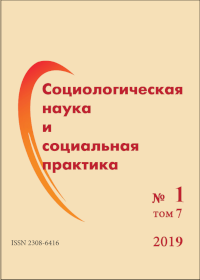Представления мигрантов из Республики Дагестан и их социального окружения о Москве и москвичах
Аннотация
Литература
Григорьева К. С., Хамидова И. А. Сельские жители Чеченской Республики о Москве и москвичах // Мониторинг общественного мнения: Экономические и социальные перемены. 2018. № 3. С. 230–247.
Пипия К. Отношение к трудовым мигрантам [Электронный ресурс] // ЛевадаЦентр. Пресс-выпуск. 28.04.2017. URL: https://www.levada.ru/2017/04/28/otnoshenie-ktrudovymmigrantam/ (дата обращения: 06.09.2018).
Пипия К. Мониторинг ксенофобских настроений, июль 2018 года [Электронный ресурс] // Левада-Центр. Пресс-выпуск. 27.08.2018. URL: https://www.levada.ru/2018/08/27/monitoringksenofobskih-nastroenij/ (дата обращения: 06.09.2018).
Том 1. Численность и размещение населения [Электронный ресурс]: Всероссийская перепись населения 2010: [веб-сайт]. Электрон. дан. URL: http://www.gks.ru/free_doc/new_site/ perepis2010/croc/perepis_itogi1612.htm (дата обращения: 06.09.2018).
Том 2. Возрастно-половой состав и состояние в браке [Электронный ресурс]: Всероссийская перепись населения 2010: [веб-сайт]. Электрон. дан. URL: http://www.gks.ru/ free_doc/new_site/perepis2010/croc/perepis_itogi1612.htm (дата обращения: 06.09.2018).
Allport G. V. The Nature of Prejudice. Reading, MA: Addison-Wesley, 1954.
Feddes A. R., Noack P., Rutland A. Direct and extended friendship effects on minority and majority children’s interethnic attitudes: A longitudinal study // Child development. 2009. Vol. 80. № 2. P. 377–390.
Paolini S. et al. Effects of direct and indirect cross-group friendships on judgments of Catholics and Protestants in Northern Ireland: The mediating role of an anxiety-reduction mechanism. Personality and Social Psychology Bulletin. 2004. Vol. 30. No. 6. P. 770–786.
Pettigrew T. F. et al. Direct and indirect intergroup contact effects on prejudice: A normative interpretation. International Journal of Intercultural Relations. 2007. Vol. 31. No. 4. P. 411–425. https:// doi.org/10.1016/j.ijintrel.2006.11.003.
Pettigrew T. F., Tropp L. R. When groups meet: The dynamics of intergroup contact. New York: Psychology Press, 2012.
Sherif M. et al. Intergroup conflict and cooperation: The Robbers Cave experiment. Norman: University Book Exchange, 1961.
Stephan W. G., Stephan C. W. Intergroup anxiety // Journal of social issues. 1985. Vol. 41. № 3. P. 157–175.
Wright S. C. et al. The extended contact effect: Knowledge of cross-group friendships and prejudice. Journal of Personality and Social psychology. 1997. Vol. 73. No. 1. P. 73–90. https://doi.org/10.1037/0022-3514.73.1.73.








 Издатель: Федеральное государственное бюджетное учреждение науки
Издатель: Федеральное государственное бюджетное учреждение науки